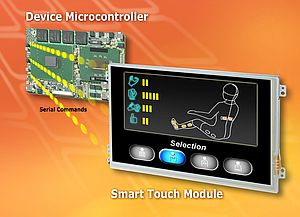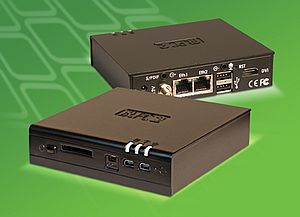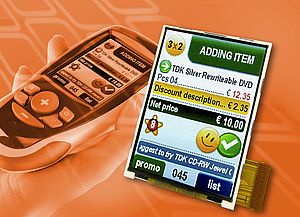The market for small/medium format (3.5”-15”) industrial TFT displays is increasing. Figures published by DisplaySearch suggest an annual growth of approximately 24%. However, the commercial risks associated with choosing this technology are also rising, and OEMs need to have adequate strategies in place for dealing with them.
Industrial TFT growth has been driven by migration of existing product applications from passive-matrix monochrome STN displays to more compelling active-matrix colour TFT options, given the enhanced performance, and considerably lower power consumption these offer. Growth is being further stimulated by the emergence of new product applications - such as home diagnostic machines, energy monitoring systems, more complex industrial control solutions, and handheld data terminals.
Next generation display interfaces will require the merging of different technical skill sets; the display, the embedded system to support it, and the GUI itself. Facing time/human resource restrictions, engineering teams must concentrate on their core competencies. As a result the majority of OEMs developing industrial designs will look to source complete TFT modules - incorporating the electronics, glass and backlight, rather than buying the component parts and trying to integrate them together. There are many such modules available from a variety of different suppliers and datasheet comparisons will often show little to choose between them. The temptation, therefore, is to pick the module with the lowest price tag. Things, however, are not that straightforward, and choosing the wrong TFT solution can significantly increase both the technical and commercial risks associated with product development and lifetime use.
To understand the various risks involved in small/medium display procurement, it is first necessary to have some comprehension of the supply base and the various drivers that affect it.
The STN market place
The industrial STN business started in Japan, before emerging in Taiwan and more recently China, and has now reached a stage of full maturity - there are many suppliers, resulting in strong competition, low cost levels, and cheap customised designs. Generally speaking STN manufacturers produce their own glass substrates, which are cut up and assembled into modules. Many manufacturers have factories which were either bought second hand or have almost fully depreciated over many years, meaning capital expenditure costs are minimal. Manufacturing the glass themselves enables their industrial OEM customers to be assured of a long-term supply and have flexibility on their ordering schedules.
Thanks to total product manufacturing autonomy, market saturation and immense competition, the OEM customer experience of STN can be very positive. Also, as it was the dominant technology for so long, what has occurred in the STN market has set the expectation level for OEMs looking to migrate to TFTs. There are, however, notable differences.
Understanding the TFT business
TFTs have a very similar construction to STN displays; a glass sandwich with a liquid crystal, colour filters, polarisers, a backlight arrangement, and the supporting driver electronics. But, the fundamental thing that differentiates them from STNs is the glass substrate (with the transistors being deposited onto the glass as a thin film). This means production of TFT glass is far more difficult, requiring heavy capital investment in state-of-the-art manufacturing facilities.
Though some STN formats have managed to cross over into the TFT domain, for the most part TFT sizes are driven by consumer product demands.
Many TFT manufacturers will not integrate touchscreens into their display modules. Those that do will mainly focus on lower end 4-wire resistive solutions. Though the market is moving towards 5-wire resistive or capacitive/projective-capacitive options, it is still very early for TFT manufacturers to offer these.
Display manufacturers will usually have to buy in touchscreens, and further down the line this can lead warranty issues, where it is difficult to determine who is responsible for product fault – the touchscreen supplier or the display manufacturer which integrated it. This becomes even more complex with emerging touch sensing technologies which require better understanding both of the technology and integration. For touch solutions that go beyond standard 4-wire resistive offerings, most TFT manufacturers will prefer their customers to deal directly with a specialist touchscreen supplier.
TFT Suppliers
The TFT business has developed geographically in a similar fashion to what took place in STN. Suppliers emerged mainly from Japan and Taiwan, with South Korea now the dominant force. TFT display module manufacturers can typically be categorised into two major groups; the Tier 1s and Tier 2s. Some Tier 1 manufacturers will use state-of-the-art fabs geared to high-volume production and typically produce full TFT modules (including the glass). Some Tier 1s focus predominantly on industrial system designs, but these will tend to have lower manufacturing outputs, leading to correspondingly higher prices.
The Tier 2s are typically unable to manufacture their own glass substrates, relying instead on Tier 1s to supply the glass for their modules. The key issues arising from this are:
1. As the glass supplied (and the specifications it conforms to) will be driven by a product that the Tier 1 has developed for a lead consumer electronics customer, it will be subject to change whenever that lead customer wants change.
2. If the lead customer’s project comes to an end, the ongoing supply of the glass will be subsequently threatened unless enough additional demand has been generated elsewhere.
3. The lead customer will be given priority by the Tier 1 on production quantities should its demand increase. This means that Tier 2s can often have difficulty in assuring consistent availability of their glass supply.
4. Tier 2s often have to work on allocation and are expected to make certain commitments, such as high minimum order quantities or paying in advance. This can result in considerable changes to payment terms and order flexibility when compared with the more familiar STN model.
5. The commodity nature of the TFT market can also expose industrial clients to price fluctuations that they would not have experienced when they relied on STN suppliers.
Being aware of what is a TFT supplier’s true focus is key here. Some will be only consumer-oriented, others will be mainly industrial. The real challenge lies with those that mix elements of both, as the balance often changes based on the underlying market trends at that time. This means that a company that engages with one of these suppliers may find that the synergy isn’t as ideal as it appeared at the beginning.
TFT Challenges
Each of the issues previously mentioned will have a direct impact on any non-consumer OEM attracted by the low price points that Tier 2 suppliers offer. Such OEMs should therefore be fully aware of the various challenges they are likely to face, and consider how to address each of these.
1. Product lifetime: Industrial/medical OEMs, for example, will often need far longer product lifespans than consumer OEMs. Lifetime guarantees will be difficult to obtain unless the customer engages with a Tier 1 specialised in supporting these sectors. Without these guarantees OEMs face the prospect of receiving end-of-life notices – should the glass format or some other key component be phased out - or having to make major (and often costly) engineering changes and going through drawn out re-approval processes.
2. Glass supply: Tier 2s can make promises to industrial clients guaranteeing continued supply, but in reality they have no control over glass delivery. Ultimately the consumer sector drives the volume and it is volume that in turn drives the manufacturing strategies and production.
3. Alternative supplies: There are no widely recognised standards for small-sized TFT modules in areas such as mechanical dimensions, connector position/format, backlight, or power supply. This hinders dual sourcing and can leave the OEM struggling to find an alternative supply if the manufacturer discontinues the module or cannot commit to delivering required volumes.
Mitigating risk
So how does one go about reaping the rewards of higher contrast ratios and faster response times enabled by TFT displays, while avoiding the many pitfalls involved? Isn’t there another alternative to engaging with an industrial-oriented Tier 1 (and accepting the high price involved) or using a Tier 2 that may be affected by future supply issues?
Fortunately, the answer is yes. For OEMs looking to mitigate the commercial and technical risks of TFT and at the same time keep costs down there is a ‘third way’. This is to collaborate with a company that is technically strong in TFTs while also demonstrating in-depth knowledge of commercial considerations.
The key is to choose a partner who sees display selection, supply chain management and integration as fundamental to their business; a company that knows how to deal with the pressures of the volatile TFT market, and can minimise the customer’s vulnerability to risk.
Anders Electronics combines display sourcing, design and integration services with testing and other procedures that can assure steady, reliable supply of optimised TFT solutions (with integrated touch functionality when required) for the lifespan of the OEM’s end product. The company combines evaluation and design services with reference platforms that simplify integration of a comprehensive range of quality TFT modules. Commercial business models guarantee availability over three- or five-year periods, with clearly defined last-time buy procedures, and long-term storage options.
Anders can further minimise risk while reducing development costs and speeding time to market, with its pre-integrated embedded user interface platforms. Each of these consists of small/medium TFT display, a high performance processor, extensive on-board memory and a wide array of I/Os. They allow engineering teams to focus all their efforts on the core areas of their application, and not be preoccupied by other concerns.




















